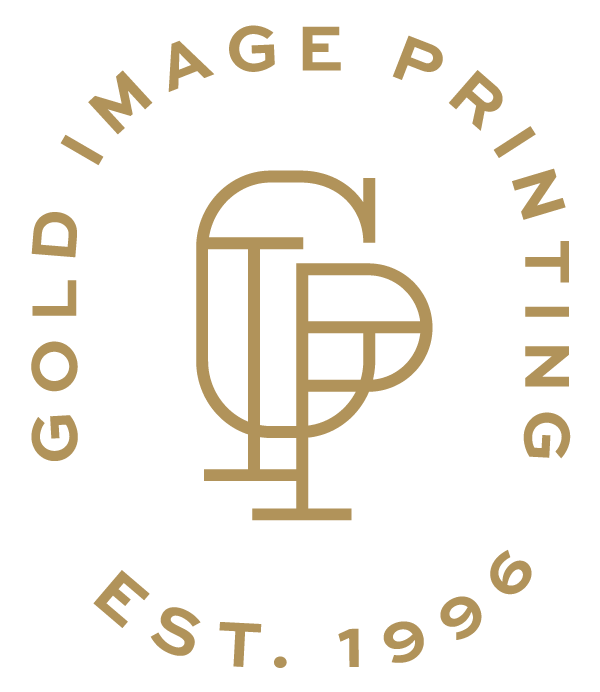Everybody loves the look of foil stamping – but most of them get scared away by the price tag! Foil stamping is a time-honored process that uses heat and a customized die to stamp metallic foil onto the page, a labor-intensive process that often brings up the cost. In recent years, a more economical option has emerged: digital foil. The process for digital foil printing is quicker, simpler, and less expensive than traditional methods – so it’s no surprise that digital foil is quickly becoming a trend in the printing industry. We’ve been seeing it everywhere, from Digital Foil Business Cards to Digital Foil Wedding Invitations, and we’re here for it! Before you jump right into designing with digital foil, however, we’re here to offer you a few insider tips to make sure that your digital foil design turns out perfectly, each and every time.
Do: Think Layers
Our digital foil printing specialty is created in several steps, using a process that relies on a digital foil printing machine. First, soft touch or velvet lamination is applied to a sheet of paper, creating a protective layer so that the digital foil isn’t accidentally applied to an area you don’t want it to be. (An additional benefit of soft touch lamination is that it creates a pleasing, silky smooth texture that is a treat to your fingers as they run across the page – it’s an entire printing specialty worth looking into.) Second, the text or graphics that you want to be coated with foil are printed on the page using black ink. Finally, the digital foil printer machine applies foil to the designated areas using a roller. You can essentially think about the process as a series of printed layers: lamination is layered over paper, ink is layered over specific areas of the lamination, and foil is layered over the ink. This is the process we use at Gold Image Printing to create all of our digital foil items, like Digital Foil Postcards and Digital Foil Greeting Cards.
Don’t: Foil over Tiny Fonts
A common mistake people make when designing for digital foil is trying to add foil to lines, fonts, or other design elements that are too small. This is an important consideration because the foil is rolled across activated ink which essentially serves as “glue” for the foil. If the area is very small, there simply may not be enough surface area for the foil to stick to. Our Artwork Guidelines can help you determine the optimal size and pixel count for your design elements. Another one of the foil printing limitations to be aware of is sometimes referred to as misalignment: the digital foil printer may experience a very slight amount of movement (1 – 3 mm) when positioning the foil elements over your design, meaning the ink and the foil may not completely overlap. The foil is much less likely to miss the ink when it’s been printed in larger fonts, with thicker lines, over larger areas of the page. So save yourself the stress and go big and bold with your digital foil design!
Do: Print on Soft Touch
Since lamination is an essential part of the layering that makes digital foil successful, this limits the types of paper stocks you can use for digital foil printing. Most of your print jobs with Gold Image Printing offer nearly unlimited paper options, but because the digital foil process is so specific, you’ll need to stick to paper that offers soft touch or velvet lamination. Luckily for you, our paper stocks collection includes several types of paper stocks for digital foil printing. You can also choose between soft touch and velvet lamination, depending on your preference, for a subtle variation in texture that will still ensure a flawless digital foil design. Our beautiful Soft Touch Wedding Invitations make it easy for you to add digital foil directly from the shopping cart!
Don’t: Overlook Traditional Foil Stamping
Although digital foil is a terrific innovation, making the favored foil treatment more accessible to customers around the world, there’s still a place for traditional foil stamping. First, foil stamping creates an indentation that you don’t get from digital foil, which is applied on top of the page rather than pressed into it. Second, once a custom die is created for your foil stamped design, it can be reused up to 100,000 times. This means that foil stamping is actually a reasonable investment for large print jobs, especially for government offices and other official organizations who print in bulk, and whose logo has been established for decades (we offer some helpful Logo Design Tips & Tricks over on the blog). Finally, foil stamping is available in more colors than digital foil, which comes in gold and silver only. If color is a priority in your design, you’ll want to consider all the options in our foil color chart. Check out our Gold Image Printing Blog post, Digital Foil Printing vs. Foil Stamping, for our insider recommendations on when to use digital foil or foil stamping for your next printing job.
Do: Try Digital Foil with Gold Image Printing
When all is said and done, digital foil is a fantastic choice for getting a gorgeous, glistening design, especially when you’re looking to save both money and time. Gold Image Printing is an expert on the digital foil printing process, and offers many stunning applications for digital foil, from Raised Digital Foil Hang Tags to Digital Foil Stickers. We consider ourselves something of a specialty printing whiz – but don’t just take our word for it! Check out our blog post, All About Specialty Printing, to learn more about digital foil and all the other incredible printing specialties we offer at Gold Image Printing, the leading online printing service!


